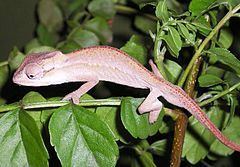Class Reptilia Family Chamaeleonidae Rank Species | Phylum Chordata Subfamily Chamaeleoninae | |
 | ||
Similar Bradypodion, Transkei dwarf chameleon, Robertson dwarf chameleon, Natal Midlands dwarf cha, Drakensberg dwarf chameleon | ||
The black-headed dwarf chameleon (Bradypodion melanocephalum) is a lizard of the family Chamaeleonidae endemic to KwaZulu-Natal, South Africa. It is also known as the KwaZulu dwarf chamaeleon.
Contents
Distribution
This chameleon is found in the coastal areas (mostly around Durban) and parts of the Midlands of southern KwaZulu-Natal, South Africa.
Taxonomy
The current species may consist of several separate species. At least three regional variants are found; one in Karkloof and Gilboa Forests, one in Weza Forest, and one in the area around Ixopo and Donnybrook.
B. melanocephalum and the Natal Midlands dwarf chameleon (B. thamnobates) may be phenotypically plastic populations of the same species, but juveniles of both species were raised under identical conditions and developed into what was phenotypically expected of their original populations, indicating they are separate species.
Description
This species is generally brownish in colour, but like other chamaeleons, can change colour and pattern to camouflage itself in its surroundings. It has been observed ranging in colour from dark brown, through light brown, olive green, to a pale creamy colour at night. The head is sometimes a darker colour than the rest of the body, but not black. The common name, black-headed dwarf chamaeleon, stems from the first specimen studied where the head had turned black in the preservation process.
Habitat
Thickets of finely branched shrubs, tall herbaceous plants, and tall grasses in undisturbed grasslands seem to be favoured. The wild date palm Phoenix reclinata is also a favoured microhabitat.
Behaviour and Biology
This reptile feeds on small insects such as flies and grasshoppers, which it captures in typical chameleon fashion with a long tongue.
It gives birth to live young in summer.
Predators of this animal include the spotted bush snake Philothamnus semivariegatus, brown-hooded kingfisher Halcyon albiventris, and domestic cats.
When threatened, it may open its mouth to reveal the bright yellow-orange interior in an attempt to scare the threat away.
Threats
The black-headed dwarf chameleon is vulnerable because of its limited distribution. It is found in a number of small nature reserves within its range, but outside of these areas, it is threatened by habitat destruction, mostly for housing and industrial development. Roads are also a threat in dividing habitats; these animals are not adapted to open areas and move very slowly, making them soft targets for predators and vehicles on open roads. It is sometimes taken as a pet, but this is illegal; no indigenous South African animal may be kept in captivity without a permit.
